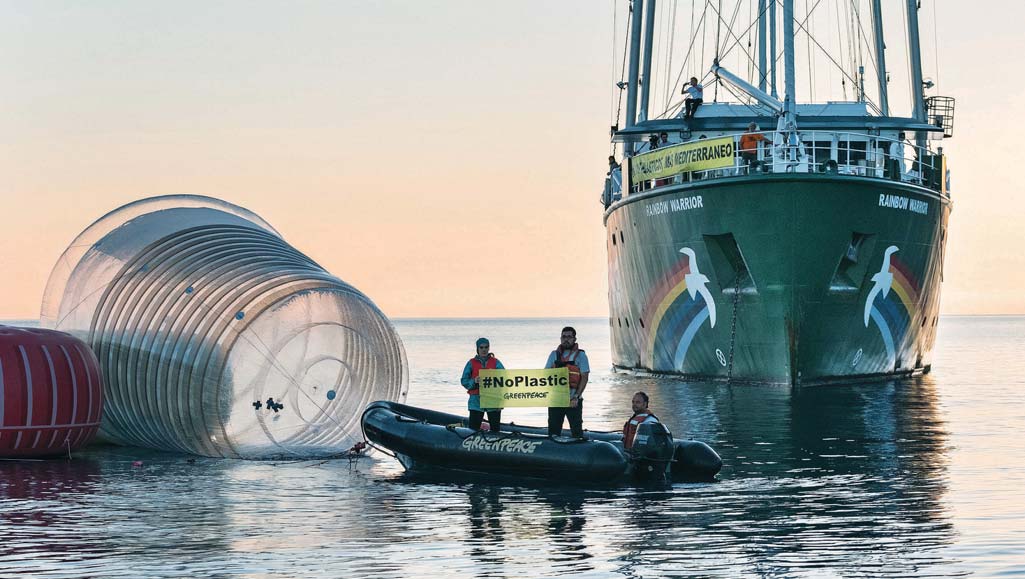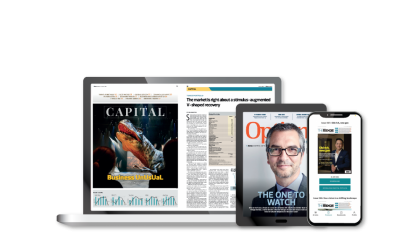
The Greenpeace campaign ship champions environmental issues around the world, from raising awareness on plastic pollution and climate change to protesting illegal shark finning activities with non-violent direction action strategies .
When Saño was 11, his grandfather, a deeply religious man, asked three things of him. The first was that he become a priest. The second was to continue being someone who stood up for what he believed in. And the third was to plant an acacia tree, rich in holy symbolism. “I took that very seriously,” he says. “I obviously didn’t become a priest but I did try to stand up for my beliefs and I did plant that tree. I nurtured it carefully and it grew to about 15ft in a few months. One day, when I came home from school, I noticed that the tree had vanished; our landlord hadn’t wanted a big tree growing in front his house and had it chopped down. I was devastated and vowed to do my best to protect every tree and living being out there. That was the start of my conscious connection with nature.” Saño would later find out that his grandfather had made the same requests of each of his grandchildren. “He even told them all to become priests so I was nothing special, but I’d like to believe he did see something in me,” he laughs. “In any case, it became a self-fulfilling prophecy.” Climate change is a pet cause, one he wrote about regularly for his high school newspaper and later professionally addressed. He helped set up the World Wildlife Fund’s climate-change policy during his 13 years with the non-profit organisation before joining the Filipino government as Climate Change Commissioner. It was a role rife with frustration as it quickly became clear that global environmental issues were deeply entangled with politics and economics. “Most emissions came from countries that have bene fited greatly from industrial activities of the past 150 years, but they refuse to take responsibility,” he says. Climate justice, which frames global warming within ethical and political contexts, demands that these countries compensate developing countries that unfairly bear some of the heavier consequences of climate change. However, arguments by the former on their sovereignty and right to development have largely placed the issue at an impasse. Saño cites the Paris Agreement of 2016 as an example. “It speaks a lot about the aspirations of the global community to find a solution, but I feel it has fallen short of what science and justice would dictate,” he says A meaningful, effective agreement can be characterised by the letters A, B, C, D and F, he continues. “It has to be ambitious, binding, comprehensive, durable and fair, and the Paris agreement simply isn’t. It should commensurate to scientific requirements, cover not just emission production but also the allocation of resources to developing countries to fight the effects. The voluntary nature of the agreement means the countries most responsible for climate change don’t have to correspondingly take more responsibility; each nation can bring to the table whatever it feels like and its contribution is measured accordingly. And because it’s not legally binding, President Donald Trump was able to walk away from the agreement in 2017, when the US has to answer for almost a quarter of the problem.”

The Rainbow Warrior’s agenda for Malaysia was plastic pollution. ‘Climate justice superstar’
In November 2013, super typhoon Haiyan — one of the strongest tropical cyclones ever recorded — ravaged the Philippines. An average of 20 storms hit the archipelagic country every year but the devastation Haiyan wreaked was unprecedented, killing thousands and displacing millions. Saño’s hometown was at the epicentre of the typhoon and, days later, he spoke before the plenary of the opening of the United Nations Climate Change Conference in Warsaw, Poland. “My brother was at home when it happened. Communication lines were down and I had no news on what was happening on the ground,” he recollects. “It was two days before I heard from him. I found out he had been helping to gather dead bodies and that food was not reaching survivors. Speaking before the delegates, imagining the worst about the situation at home, was incredibly tough.” Saño was grief-stricken and his heartfelt speech led The Guardian to call the Filipino chief negotiator “an unlikely climate justice superstar”, putting a human face to a problem previously characterised by statistics. “I hate being the face of a movement, but I do believe that, sometimes, movements have to have a face,” he said in an interview with the UK newspaper. It was an unscripted pledge that framed him as such. Immediately following his speech, he said, “In solidarity with my countrymen who are struggling to find food back home and with my brother, who has not had food for the last three days… I will now commence a voluntary fasting for the climate. This means I will voluntarily refrain from eating food during this conference until a meaningful outcome is in sight.” There were several times when Saño was certain he would give up on governmental work, or what he described as “a convoluted political process where diplomatic and political compromises are more important than the well-being of humanity and the planet”. But this was the straw that broke the camel’s back. “We’re about to have the 24th summit of the UN Climate Convention this year, which means it’s been more than two decades since the world decided we needed to have an international agreement on climate change,” he says, shaking his head. “While it was encouraging to see countries coming together on this, what was happening on the ground often did not commensurate with the scale of the problem, and there was little urgency. It felt like some countries were stalling the process in very devious ways; they were well-resourced and appeared to be in sync with plans but, behind closed doors, in private negotiations, they pulled strings, employed delaying tactics and even bullied poorer countries into submission, leveraging the dependency of the latter on them for economic aid. I witnessed it first-hand numerous times and decided to leave government and return to the grassroots.” Offers poured in from regional and international organisations, but Saño decided to take time off and embark on a special journey, joining global multi-faith climate campaign OurVoices as a leader of The People’s Pilgrimage. A series of pilgrimages around the world would pay homage to global climate change hotspots such as Korea, Indonesia, the Great Barrier Reef, India, Africa and the Americas. It culminated in a 1,500km walk from Rome to Paris over 60 days, arriving in time for the UN Climate Change Summit at the end of November 2015. The pilgrimage would prove serendipitous. Saño, who had vowed to participate in every single walk, came across the Rainbow Warrior when it was docked in Vanuatu during his visit to the Pacific island nation after it had been devastated by Cyclone Pam. He would soon be invited to join Greenpeace. It had been a childhood dream of his, so he naturally accepted the invitation. “Greenpeace stands for a lot of good things,” he says of his decision. “It has inevitably attracted some controversy and made some high-profile blunders along the way, but it has learnt from its mistakes. I was fascinated by its work in Southeast Asia, especially when it started campaigning on climate justice. I thought its resources could help me really drive change.” Fighting to protect the environment
Southeast Asia is a key battleground in the fight for environmental protection. It has the fastest deforestation rates in the world, with a forest the size of a football field lost every second. Those are actual and official statistics. While most of the world is veering away from coal as a primary fuel and looking at clean energy, the region is still courting coal purveyors globally, with dozens of coal-fired power plant projects in the pipeline. Plastic is another vital issue; our corner of the world accounts for 60% of its pollution in the ocean. “We sit at the epicentre of plastic pollution,” says the regional executive director. “It sounds like a trivial, aesthetic issue, but there are terrible side effects. New research suggests plastic is linked to hormone-related illnesses and lower fertility rates. The problem is particularly pressing here because of our culture of consumption, our insistence on convenience and the lack of a robust regulatory environment regarding its use. In odd instances where there are plastic waste management policies or mechanisms, enforcement is poorer here than anywhere else. We don’t have a strong ‘eat local’ mentality and imported food requires heavy packaging. We have a terrible sachet habit too — soaps, sauces, threein-one coffees. Greenpeace has attempted to engage the relevant companies, but high profits means producers have little incentive to change. They pretend token [corporate social responsibility] activities offset this, but there is a large elephant in the room. Plastic is a by-product of the petroleum industry. We are trying to investigate whether oil companies are propagating increased plastic production to make this their eventual bread and butter to counter the decline of oil as a primary fuel.” Urgency is rising, but Saño is adamant that solutions have to be peacefully brokered. “These conversations have to happen on the ground and in boardrooms — both are arenas in which financial decisions are made. Because we are empowered by our legacy, reach and breadth, and work with millions of people around the world, we can effectively identify pressure points and leverage grassroots power to change mindsets and business models,” he says. “Peace is a value proposition. Doing things any other way means doing things violently, and this is a war that can’t be won in the chambers of war, but in the chambers of the heart. I believe in the power of people in pressuring governments and changing power dynamics. I have to congratulate Malaysia for reminding us of this in your recent election.” It is messy work and the slog is long and hard, but Saño is personally motivated. “I have two children and I want to be able to look them in the eye and tell them I did my best,” he says. “If there is even a one-in-a-million chance that we can win this, we have to try. I see signs of hope. More individuals are adopting greener lifestyles and demanding more responsible practices by corporations.” As for that self-imposed hunger strike at the 2013 United Nations Climate Change Conference in Warsaw, he says, “They were more interested in making sure the commas and full-stops were in the right place in the writing of inconsequential details than they were in concretely addressing pressing issues,” Saño says drily. The two-week summit concluded without a morsel of food passing his lips.
Petrina Fernandez is a senior writer with the Options desk at The Edge Malaysia This article appeared in Issue 841 (July 30) of The Edge Singapore. Subscribe to The Edge now








